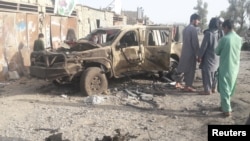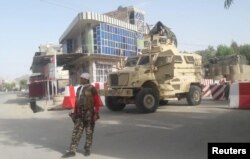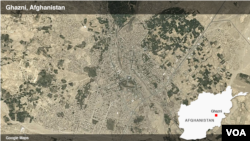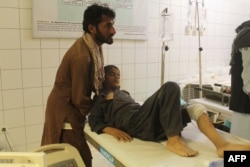Afghan security forces re-established full government control Wednesday over the capital of western Farah province, a day after the Taliban insurgency came close to capturing the city near the Iranian border.
A major coordinated assault early Tuesday had enabled the insurgents to enter Farah and take control of key government installations, including police and intelligence headquarters.
Provincial governor Abdul Baser Salangi told VOA a counteroffensive by Afghan forces, backed by U.S. airstrikes, inflicted more than 300 fatalities on the Taliban, forcing the rebels to retreat from the city.
Salangi also confirmed the killing of at least 25 Afghan forces and several civilians in Tuesday's clashes with insurgents. He estimated that about 2,000 rebel fighters took part in the attack.
The U.S. military also released video footage of airstrikes it conducted on Taliban positions in support of Afghan forces.
But Taliban spokesman Qari Yousaf Ahmadi rejected the official claims, saying its fighters killed 63 "enemy" forces before staging a "tactical" withdrawal from Farah to transport seized military equipment and vehicles back to their bases around the city.
Ahmadi asserted the Taliban lost only nine combatants after achieving its mission, and without any opposition, withdrew from the area — claims residents also reportedly supported.
Witnesses said life returned to normal and markets opened after the fighting died down on Wednesday. A large number of families who had fled Tuesday's fighting also returned to their homes.
Afghan officials praised the U.S.-backed security forces for retaking control of Farah. Reports quoted residents, however, as saying Taliban fighters were patrolling city streets without fear after capturing parts of it.
Local media quoted the provincial police chief on Wednesday as alleging Iran was funding and arming Taliban insurgents in Farah. Tehran acknowledges contacts with the insurgents, but denies providing any military support.
The insurgent advances in Farah, though short-lived, have refueled criticism of President Ashraf Ghani's central government.
A city of about 50,000 people, Farah is a major poppy-producing area in western Afghanistan and has been under pressure from the Taliban since 2016, when the rebels came close to almost overrunning it.
Ghazni clashes
Meanwhile, fierce clashes reportedly were raging in two districts of the troubled central province of Ghazni after Taliban insurgents launched major attacks overnight. Local media quoted members of the provincial council as saying the fighting in Zana Khan and Jaghato districts killed at least 22 Afghan security personnel.
Since launching its annual spring offensive three weeks ago, the Taliban have made significant territorial advances and inflicted heavy casualties on government forces. The fighting and attacks have killed nearly 400 Afghan forces since the beginning of May.
Separately, President Ghani apologized Wednesday to the families of civilians who lost their children last month in airstrikes the Afghan air force conducted on a religious seminary or madrasa in the northern Kunduz province.
A United Nations probe into the April 2 attack in Taliban-controlled Dasht-e-Archi district confirmed the killing of 36 civilians, including 30 children. More than 50 children were among 71 wounded.
The government had insisted from the outset the air force targeted a Taliban base in the district and denied civilians had been hurt. An official statement said Wednesday that President Ghani met families of the victims, as well as elders from Kunduz, and he apologized for the incident.
A presidential statement quoted Ghani as saying the "difference between evildoers and a legitimate government is that a legitimate government apologizes for the mistakes made. The president promised that the government would pay compensation to the families.












